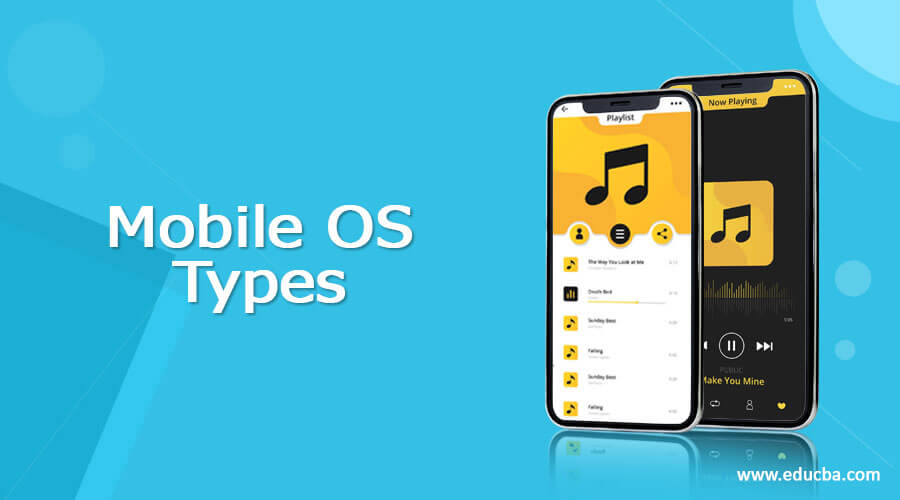Updated June 1, 2023

Introduction to Mobile OS Types
Mobile OS Types is the type of Operating system present in Mobiles. Operating System is a software interface responsible for managing and operating hardware units. People used mobile phones to make calls and send text messages in the past. Nowadays, mobile phones are close to handheld computers, enabling them to send emails, watch news, make video calls, play games, and so on. OS, also known as Operating System, are software running on desktops and laptops that manage memory and resources when multitasking. Most mobile operating systems work on specific hardware, such as Motorola runs on Android, whereas iPhone runs on iOS. When you buy a mobile, the manufacturer has already designed it with a particular operating system. Before purchasing a mobile, it is good to learn about all the Operating System types to ensure device compatibility and support for applications.
Different Types of Mobile OS
We shall go through the most popular Operating system platforms –
1. Symbian Operating System
It is the operating system that provides high-level integration along with communication. It was developed by Symbian Ltd. in 1998 and is based on the Java programming language. Nokia Manufacturer was the first to use this Symbian Operating System. It combines wireless communication and personal information management, i.e., PIM, which consists of agenda and contacts. Nokia has made this an open and direct model to work with other OEMs. It comprises multiple layers such as application engines, MKV, OS libraries, Base kernels, servers, and hardware interface layers. Japanese manufacturers mostly used it for mobiles sold in Japan. Specific Sony Ericsson mobile devices also incorporate this operating system.
2. BlackBerry Operating System
The operating system developed by Research in Motion (RIM) is specifically designed for use on popular BlackBerry handheld devices. It is known for native support for corporate mail via MIDP, allowing wireless activation and synchronization with Lotus Domino and Microsoft Exchange. Based on research, approximately 45% of mobile developers were using BlackBerry OS at the time of publication. BlackBerry provides API classes for developers to code applications. It runs only on BlackBerry phones such as Curve, Perl, BlackBerry Bold, and Storm. All applications under BlackBerry are written using the Java programming language, and users can install them exclusively from the BlackBerry App World through the BlackBerry Desktop Manager.
3. Android Operating System
It is the most common operating system developed by Google in 2008. It is a free and open-source operating system based on Linux Kernel. Android has a large base of developers coding applications and extending the functionality of devices. Android OS names change with every version, such as Donut, Éclair, Oreo, etc. Android dominates over other Operating Systems based on a broad spectrum of users. Users can customize multiple screens with useful widgets and give quick, easy access to functions and content users care of. It can multi-task and has an Android Marketplace equivalent to iOS Apple Store.
4. Apple iOS
Apple Inc. developed an operating system specifically for the iPhone, which was later expanded to include iPad, iPod Touch, and other Apple devices. It is a secure operating system only available for Apple products as the company does not license it for third-party hardware. iOS respond to users’ touch by a tap on a screen to open the program, pinching fingers together to enlarge or minimize image, and swiping fingers across the screen to change pages. Users can download millions of applications on the Apple App Store directly to any device which is running on iOS. Apple iOS holds the distinction of being the second top-selling operating system for mobiles. The iOS user interface has remained unchanged since the inception of the first iOS mobile in 2007. The main difference between Android and iOS is that iOS runs only on Apple products.
5. Windows Operating System
Microsoft developed an operating system primarily for pocket personal computers and mobile phones. It has computer-based Windows OS features and some additional features for smartphones. The Mobile Operating system is based on Windows CE Kernel 5.2 and comes with a mobile-optimized version of IE for exploring the web and supporting corporate mail accounts. In 2010, Windows released a revamped version of its Windows platform when its software fell behind iOS and Android. It is recognizable easily with a tile-based interface whose features are removable and exchangeable sections on the home screen serving its purpose. It has a separate corner for kids so they do not reach personal data and misuse it.
Conclusion
With this, we shall conclude the topic“Mobile OS Type.” We have seen what Mobile OS Types mean and how they are classified. We have seen OS Types from Android to iOS, Windows, BlackBerry, and Symbian. Each operating system has its purpose of serving smartphones, and each has its features, specifications, etc. Many more operating systems remain to be listed, including Harmony OS, Palm OS, Bada, WebOS (HP), MeeGo OS, Kai OS, Plasma OS, Sailfish OS, and numerous others. Hope this topic has given a clear view of the various operating systems on which smartphones are built.
Recommended Articles
This is a guide to Mobile OS Types. Here we discuss the introduction and list of different types of Mobile OS in detail. You may also have a look at the following articles to learn more –


